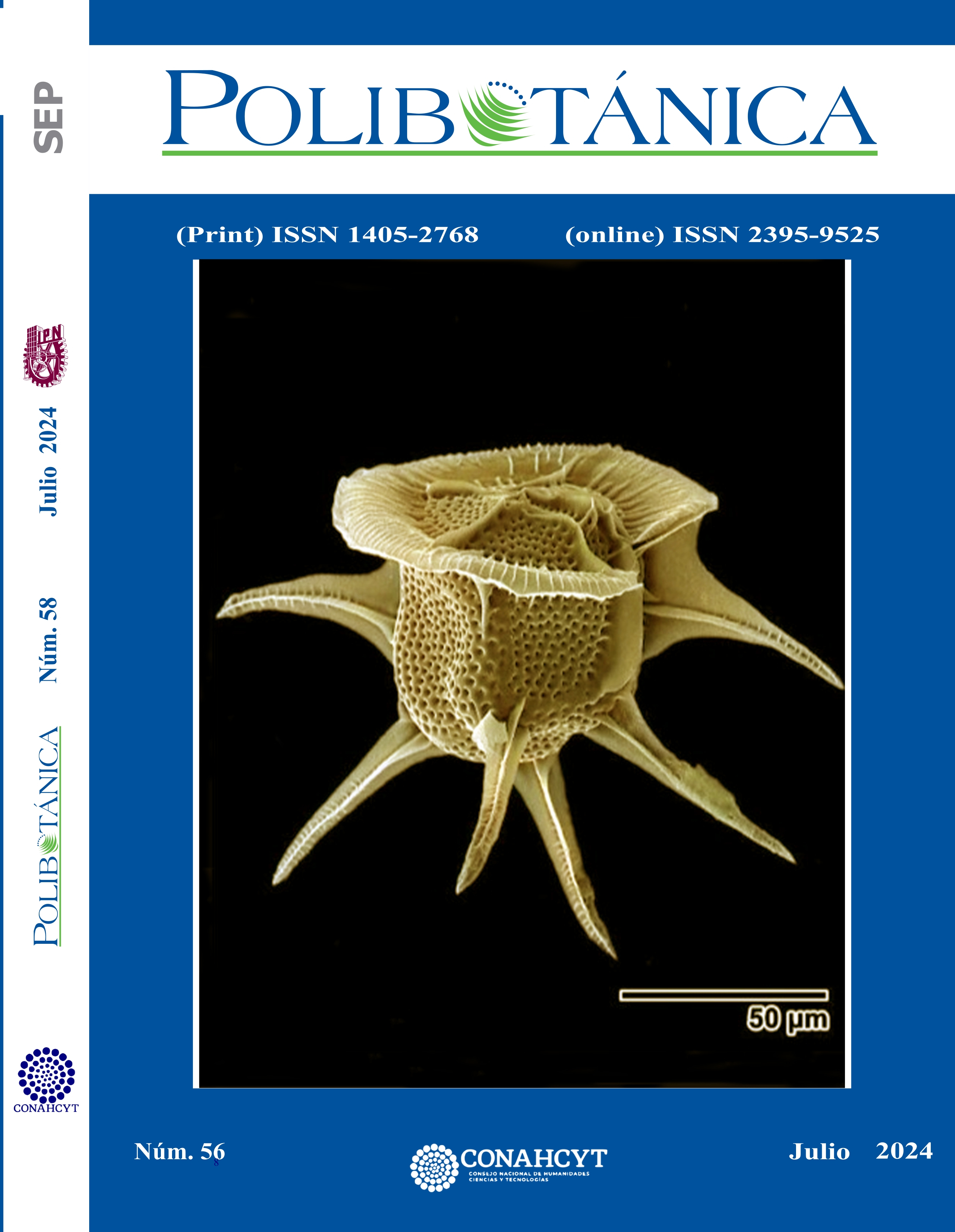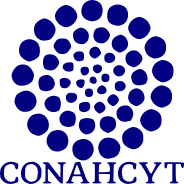Treatments that promote seeds germination of five woody species of the Tamaulipan Thornscrub with physical dormancy
DOI:
https://doi.org/10.18387/polibotanica.58.11Keywords:
SULFURIC ACID, SCARIFICATION, FABACEAS, HIDROGEN PEROXIDE, PREGERMINATION TREATMENSAbstract
Many forest species of the Tamaulipan thornscrub present germination problems that limit nursery propagation for use in restoration or reforestation projects;therefore, it is necessary to improve seed germination. The objective of this study was to define treatments that promote germination in seeds of five Tamaulipan thornscrub species with physical dormancy. The species studied were: Ebanopsis ebano, Havardia pallens, Parkinsonia aculeata, Prosopis laevigata and Vachellia farnesiana. Seed was collected from natural populations with an adequate degree of conservation and from phenotypically superior individuals. Several scarification treatments were examined, consisting of different immersion times in hydrogen peroxide, boiling water and sulfuric acid, in addition to a control treatment. The trial was carried out in Petri dishes with filter paper inside a germination chamber under controlled conditions of humidity and temperature. A completely randomized experimental design was used with four replicates of 50 seeds per species. Germination was counted for 16 days considering the emergence of the 1 cm long radicle. The germination percentage was determined and cumulative germination curves were constructed. For each species, an analysis of variance was performed and the means were compared with Tukey's test, at a significance level of 0.05. The treatments analyzed significantly affected seed germination in all the species evaluated (P<0.05). Each treatment had a different effect depending on the species, highlighting that in most of them, as is the case of Ebanopsis ebano, Havardia pallens, Prosopis laevigata and Vachellia farnesiana, the treatments with sulfuric acid worked, but with different immersion times (5 or 25 min). In Parkinsonia aculeata, the germination increased when the seeds were soaked in water for 5 minutes. These results have practical implications for improving seed management of the species studied in restoration or reforestation projects in the Tamaulipan thornscrub.
References
Arriaga, L. (2009). Implicaciones del cambio de uso de suelo en la biodiversidad de los matorrales xerófilos: un enfoque multiescalar. Investigación Ambiental, 1(1), 6 –16. https://doi.org/10.4067/s0718-27912009000300003
Baskin, C. C. & Baskin, J. M. (2014). Seeds: Ecology, Biogeography and Evolution of Dormancy and Germination, Second Edition. Academic Press.
Bewley, J. D. & Black, M. (1994). Seeds. Physiology of development and germination, Second Edition. Plenum Press.
Bareke, T. (2018). Biology of seed development and germination physiology. Advance in Plants & Agriculture Research, 8(4), 336–346. https://doi.org/10.15406/apar.2018.08.00336
Barone, J., Duarte, E. & Luna, C. (2016). Determinación de la eficacia de métodos de evaluación de calidad de semillas de especies forestales nativas de la Selva Atlántica. Quebracho Revista de Ciencias Forestales, 24(2), 70–80.
Calixto Valencia, C.G., Cetina Alcalá, V.M., Ramírez Herrera, C., López López, M.Á., Ángeles-Pérez, G., Equihua Martínez, A. & Basave Villalobos, E. (2022). Características morfométricas, reproductivas y germinativas del germoplasma de Swietenia humilis Zucc. en Guerrero. Revista Mexicana de Ciencias Forestales, 13(72), 148–172. https://doi.org/10.29298/rmcf.v13i72.1250
Camacho M., F. 2011. Dormición de semillas: causas y tratamentos. 2ª ed. Trillas.
Céspedes, F. & Moreno S., E. (2010). Estimación del valor de la pérdida de recurso forestal y su relación con la reforestación en las entidades federativas de México. Investigación Ambiental, 2(2), 5–13. https://doi.org/10.2307/j.ctv1xxvwr.9
CONABIO (Comisión nacional para el Conocimiento y Uso de la Biodiversidad). (22 de noviembre de 2021). Matorrales. Biodiversidad Méxicana. https://www.biodiversidad.gob.mx/ecosistemas/Matorral.
Comisión Nacional Forestal (CONAFOR). (2016). Manual para la identificación y establecimiento de unidades productoras de germoplasma forestal. Comisión Nacional Forestal y Secretaría del Medio Ambiente y Recursos Naturales (Semarnat).
Everitt, J. H. (1983). Seed germination characteristics of two woody legumes (Retama and Twisted Acacia) from South Texas. Journal of Range Management, 36(4), 411–414. https://doi.org/ 10.2307/3897928
Finch‐Savage, W. E. & Leubner‐Metzger, G. (2006). La latencia de las semillas y el control de germinación. New phytologist, 171 (3), 501–523. https://doi.org/10.1111/j.1469-8137.2006.01787.x
García, J. & Jurado, E. (2008). Caracterización del matorral con condiciones prístinas en Linares N.L., México. Ra Ximhai, 4(1), 1–21. https://doi.org/10.35197/rx.04.01.2008.01.jghej
García A., L., Labrada-Delgado, G. J., Montalvo-González, E. & Loza-Cornejo, S. (2022). Caracteres morfométricos y anatómicos de frutos y semillas de Prosopis laevigata (Fabaceae) en Lagos de Moreno, Jalisco, México. Acta Botánica Mexicana, e2057(129). https://doi.org/10.21829/ABM129.2022.2057
González M., F. (2003). Las comunidades vegetales de México. Propuesta para la unificación de la clasificación y nomenclatura de la vegetación de México. Instituto Nacional de Ecología.
Hernández, V. G., Sánchez V., L. R. & Aragón, F. (2001). Tratamientos pregerminativos en cuatro especies arbóreas de uso forrajero de la selva baja caducifolia de la sierra de Mazatlán. Foresta Veracruzana, 3(1), 9–15. https://doi.org/10.21829/myb.2017.2331426
Khurana, E. & Singh, J. S. (2001). Ecology of seed and seedling growth for conservation and restoration of tropical dry forest: a review. Environmental Conservation, 28(1), 39–52. https://doi.org/10.1017/S0376892901000042.
Landis, T. D., Tinus, R. W. & Barnett, J. P. (1998). The container tree nursery manual, Vol. 6, Seedling propagation. Agriculture Handbook 674. USDA Forest Service.
Luera, P., Wahl V., K., Christoffersen, B. O., Treviño, A., Soti, P. & Gabler, C. A. (2021). Effects of scarification, phytohormones, soil type, and warming on the germination and/or seedling performance of three Tamaulipan thornscrub forest species. Plants, 10, 1489. https://doi.org/10.3390/plants10081489
Luna-Nieves, A. L., Meave, J. A., González, E. J., Cortés-Flores, J. & Ibarra-Manríquez G. (2019). Guiding seed source selection for the production of tropical dry forest trees: Coulteria platyloba as study model. Forest Ecology and Management, 446, 105–114. https://doi.org/10.1016/j.foreco.2019.05.020.
McCaughey E., Ayala, G. I., Burboa, M. G., Retes, R. & Ochoa, A. (2018). Use of native plants for the rehabilitation of quarries in Sonora. Idesia, 36(4), 17–24. https://dx.doi.org/10.4067/S0718-34292018005002401
Molina, V. M., Pando, M., Alanís, E., Canizales, P. A., González, H. & Jiménez, J. (2013). Composición y diversidad vegetal de dos sistemas de pastoreo en el matorral espinoso tamaulipeco del Noreste de México. Revista Mexicana de Ciencias Pecuarias, 4(2), 361–371. https://doi.org/10.21829/abm110.2015.187
Molina, V.M., Mora, A., Alanís, E., Soto, B. & Patiño, A. M. (2019). Plantas características del matorral espinoso tamaulipeco en México. Editorial Universitaria de la Universidad Autónoma de Nuevo León.
Núñez-Cruz, A., Meave, J. A. & Bonfil, C. (2018). Reproductive phenology and seed germination in eight tree species from a seasonally dry tropical forest of Morelos, Mexico: Implications for community-oriented restoration and conservation. Tropical Conservation Science, 11, 1–14. https://doi.org/10.1177/1940082917749946.
Pequeño-Ledezma, M. A., Alanís-Rodríguez, E., Jiménez-Pérez, J., González-Tagle, M. A., Yerena-Yamallel, J. I., Cuellar-Rodríguez, G. & Mora-Olivo, A. (2012). Análisis de la restauración pasiva post-pecuaria en el matorral espinoso tamaulipeco del noreste de México. CienciaUAT, 7(1), 48–53. https://doi.org/10.29059/cienciauat.v7i1.39
Romero-Saritama, J.M. & Pérez R., C. (2016). Rasgos morfológicos de semillas y su implicación en la conservación ex situ de especies leñosas en los bosques secos tumbesinos. Ecosistemas, 25(2), 59–65. https://doi.org/10.7818/ECOS.2016.25-2.07
Sobrevilla-Solís, J. A., López-Herrera, M., López-Escamilla, A. L. & Romero-Bautista, L. (2013). Evaluación de diferentes tratamientos pregerminativos y osmóticos en la germinación de semillas de Prosopis laevigata (Humb. & Bonpl. ex Willd) M. C. Johnston. Estudios científicos en el estado de Hidalgo y zonas aledañas, Volumen II. Zea Books.
Villarreal, J. A., Rocha E., A., Cárdenas-Ávila, M. L., Moreno L, S., González A., M. & Vargas L, V. (2013). Caracterización morfométrica, viabilidad y germinación de semillas de mezquite y huizache en el noreste de México. Phyton (Buenos Aires), 82(2), 169–174.
Viveros V., H., Hernández P., J. D., Velasco G., M. V., Robles S., R., Ruiz M., C., Aparicio R., A., Martínez H, M. J., Hernández Villa, J. & Hernández H., M. L. (2015). Análisis de semilla, tratamientos pregerminativos de Enterolobium cyclocarpum (Jacq.) Griseb. y su crecimiento inicial. Revista Mexicana de Ciencias Forestales 6(30), 52–65. https://doi.org/10.29298/rmcf.v6i30.207
von Maydell, H. J. (1995). Appraisal of Practices to Manage Woody Plants in Semi-Arid Environments. In S. Bruns, J. Furberg, O. Luukkanen, & P. Wood (Eds.), Dryland Forestry Research (pp. 15-30). Hyytiala: Proc. IFS/IUFRO Workshop.
Zar, J. H. (1999). Biostatistical Analysis, Fourth Edition. Prentice Hall.
Downloads
Published
Issue
Section
License

Polibotánica by Departamento de Botánica de la Escuela Nacional de Ciencias Biológicas del Instituto Politécnico Nacional se distribuye bajo una Licencia Creative Commons Atribución-NoComercial-CompartirIgual 4.0 Internacional.




















